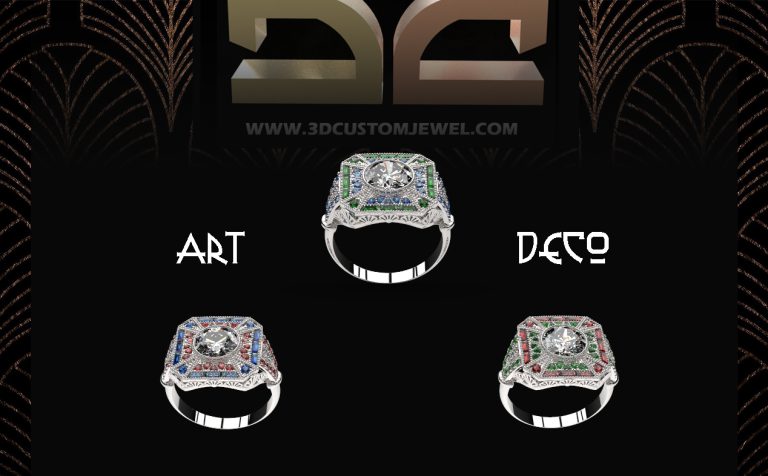This ring is inspired by Art Deco.
Art Deco was a popular #design movement from 1920 to 1939 (whose influence extends until 1950 in some countries) that influenced decorative arts such as architecture, interior design, and graphic and industrial design, as well as visual arts such as #fashion, painting, #engraving, #sculpture and filmmaking.
After the Universal Exposition of 1900 in Paris, several French #artists (Héctor Guimard, Eugene Grasset, Raoul Lachenal, Paul Follot, Maurice Dufrene and Emile Decour) formed a formal collective dedicated to the avant-garde decorative #arts. In 1925 they organized the Exposition Internationale des Arts. Décoratifs et Industriels Modernes (International Exhibition of Modern Decorative and Industrial Arts) in Paris, and called themselves “the modern ones”; actually, the term art #deco was coined in the retrospective entitled “Les Années 25”, held in Paris at the Musée des Arts Décoratifs (Museum of Decorative #Arts) from March 3 to May 16, 1966; the term is therefore an apocope of the French word décoratif.
Finally, let us quote two definitions of Art Deco.
Alastair Duncan, defines Art deco as follows:
“It is not easy to define the main characteristics of Art Deco, because the #style attracted a multitude of diverse and often contradictory influences. Many of them came from the avant-garde pictorial #styles of the early years of the century, such as Cubism, Russian Constructivism and Italian Futurism – abstraction, distortion and simplification – all evident in Art Deco decorative vernacular arts. But these were not all: a repertoire examination of standardized motifs of style such as stylized #flower #bouquets, young maidens, geometric and ubiquitous fruits, reveal influences from the world of high fashion, Egypt, the Orient, tribal Africa and the Russian Ballets of Diaghilev. From 1925 the growing impact of the machine can be discerned in repeated and superimposed images, or later in the thirties, by modernized forms derived from aerodynamic principles. All this resulted in a high amalgam of complex artistic influences, described defiantly by a simple phrase, the term Art Deco”.
Nancy Susan Sternau in her book “Art Deco: Flights of #Artistic Fancy” describes it as follows:
“Developed in Paris and later fostered in Hollywood as the style of the #stars, Art Deco made the transition, in a few years, from a primary French style to a universally understood symbol of glamor. Art Deco is a convenient term used to describe decorative art in the period between the two world wars, and refers to a style that is #classic, #symmetrical and rectilinear. As a movement it as a movement it developed during the years 1908 to 1912 and reached a high point from 1925 to 1935. This style was the product of influences as diverse as Art Nouveau, Cubism, the #Bauhaus and Egyptian art, the East, Africa and the Americas”


